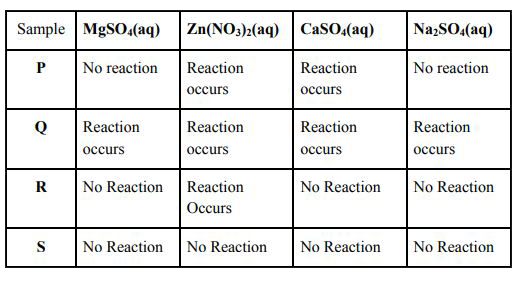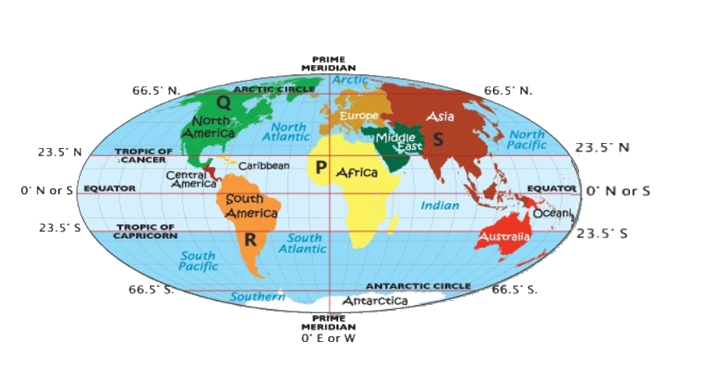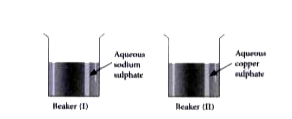The following observations were made by a student on treating four metals P, Q, R and S with the given salt solutions:

Based on the above observations:
(a) Arrange the given samples in the increasing order of reactivity
(b) Write the chemical formulae of products formed when Q reacts with CuSO4 solution.
i. S>R>P>Q
ii. Cu and QSO4
Topper's Solved these Questions
- SAMPLE QUESTION PAPER 2020-21 (SCIENCE)BOOK - CBSE MODEL PAPERCHAPTER - SAMPLE QUESTION PAPER 2020-21 (SCIENCE)EXERCISE - SECTION C
7 Videos
- SAMPLE QUESTION PAPER 2020-21 (SCIENCE)BOOK - CBSE MODEL PAPERCHAPTER - SAMPLE QUESTION PAPER 2020-21 (SCIENCE)EXERCISE - SECTION D
5 Videos
- SAMPLE QUESTION PAPER 2020-21 (SCIENCE)BOOK - CBSE MODEL PAPERCHAPTER - SAMPLE QUESTION PAPER 2020-21 (SCIENCE)EXERCISE - SECTION D
5 Videos
- SAMPLE PAPER 2023 TERM IBOOK - CBSE MODEL PAPERCHAPTER - SAMPLE PAPER 2023 TERM IEXERCISE - SECTION-E
3 Videos
Similar Questions
P, Q R and S four places in the world as given in the following map. Arrange these places in increasing order of their biodiversity.

View SolutionAn element P(atomic number 20) reacts with an element Q (atomic number 17) to form a compound. Answer the following questions giving reasons :
(a) Write the positions of P and Q in the Modern Periodic Table.
(b) Write the molecular formula of the compound when P reacts with Q.
View Solution
Knowledge Check
The table given below, in which samples of four metals P, Q, R and S were taken and added to the following solutions one by one . The result obtained have been tabulated as follows

Which is the most reactive metal ?APBQCRDSThe table given below, in which samples of four metals P, Q, R and S were taken and added to the following solutions one by one . The result obtained have been tabulated as follows

Which is the least reactive metal ?APBRCQDSA novel species with double stranded genetic material consists of 5 bases namely P, Q, R, S& T with percentages given below

Based on the above information which , ONE of the following inferences is NOT supported by the observations ?AS base pairs with T , and Q base Pairs with RBS base pairs with Q , and T base pairs with QCP base pairs with R , and S base pairs with QDP base pairs with R , and T base pairs with Q
A group of students looked at different metals and metal sulphate solutions given in a tabular form. From the data answer the following :
(i) Which metal reacted with all other metal sulphate solutions ?
(ii) Which metal did not react with any other metal sulphate solution ?
(iii) Put the metals in decreasing order of reactivity.
(iv) Iron is slightly more reactive than cobalt. With which other metal sulphate solution, will it react ?
MetalMetal sulphate solutionColourChromiumChromium sulphategreenCobaltCobalt sulphatepinkCopperCopper sulphateblueMagnesiumMagnesium sulphateColourless
View SolutionSome of the elements and their atomic numbers are given in the table.
(i) How many valence electrons are there in the element R ?
(ii) What is the valency of P?
(iii) Write the chemical formula of the compound formed by combining the elements P and Q.

View SolutionMagnesium powder was added to two different salt solutions in beakers (I) and (II) as shown in the given figures. Answer the questions that follow:

What can you deduce about the order of reactivity of the three metals? Write the order.
View SolutionWrite equations to represent the following observations: When NaOH is added to aqueous CuSO4 solutin, a pale blue precipitate is formed. On adding aqeous NH3 solution, When NaOH is added to give a deep blue solution. If the solution is made acidic with dilute HNO3, the colour is converted back to pale blue solution.
View SolutionThe table probides the pH value of four solutions P, Q, R and s

Which of the following correctly represents the solutions in increasing order of their hydronium ion concentration ?
View Solution
